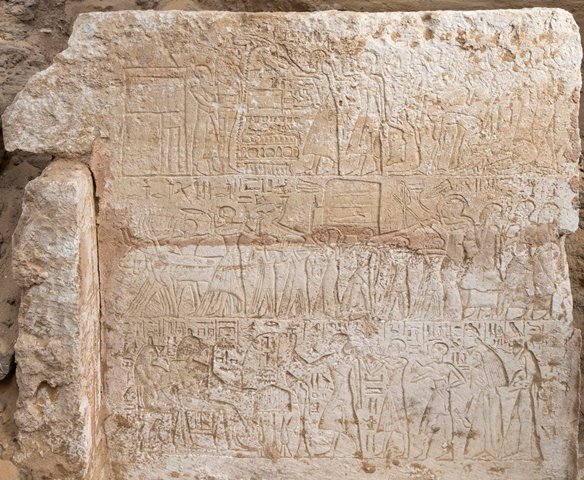“The new discovery sheds new light on the development of Saqqara Necropolis during the Ramesside period and introduces new individuals that were yet unknown in the historical sources,” said Mostafa Waziri, secretary-general of the Supreme Council of Antiquities.
The tomb of Panehsy, which has the form of a freestanding temple with a gate entrance, an inner courtyard with columned porticoes, and a shaft to the underground burial chambers, is situated north to the tomb of the famous Maya, the high-ranking official from the time of Tutankhamun. The mud brick walls of the upper structure are 1.5 metres high and embellished with decorated limestone revetment slabs. These show the colourful reliefs of the tomb owner and his wife Baia, who was the singer of Amun, along with several priests and offering bearers.
Christian Greco, director of the Museo Egizio in Turin, said the most beautiful representation depicts Panehsy worshipping the cow goddess Hathor. Beneath it, Panehsy and Baia sit together before an offering table. A bald man with a leopard skin around his shoulders stands opposite the couple. This was the priest who took care of their mortuary cult, pouring out water.

Lara Weiss, curator of Leiden's Egyptian and Nubian collection, pointed out that during excavation work, the mission stumbled upon four smaller tomb chapels located to the east of Panehsy's tomb, one of which is of the gold foil-maker of the treasury of the Pharaoh Yuyu. The tombs are very well preserved, and their walls bear high-quality, detailed, and stunning decorations. Although it is a relatively small tomb chapel, four generations of Yuyu's family were venerated in beautiful colourful reliefs showing Yuyu's funerary procession and the reviving of his mummy to live in the afterlife as well as the veneration of the Hathor cow and the barque of the local Saqqara god Sokar.
Another notable find was made at the eastern side of Panehsy's tomb, where a yet anonymous chapel with a very rare sculptured representation of the tomb's owner and his family was discovered. The artistic style of the representation might have been inspired by the statues neighbouring the tomb of Maya and Merit.

The archaeological mission aims to understand the history of Saqqara, one of the most important burial sites of ancient Egypt. The Leiden Museum conducted research in Saqqara together with the Egypt Exploration Society of London from 1975 to 1998. Since 1999, Leiden University has been a partner in the project, and in 2015 the Museo Egizio in Turin joined the mission.

Short link: